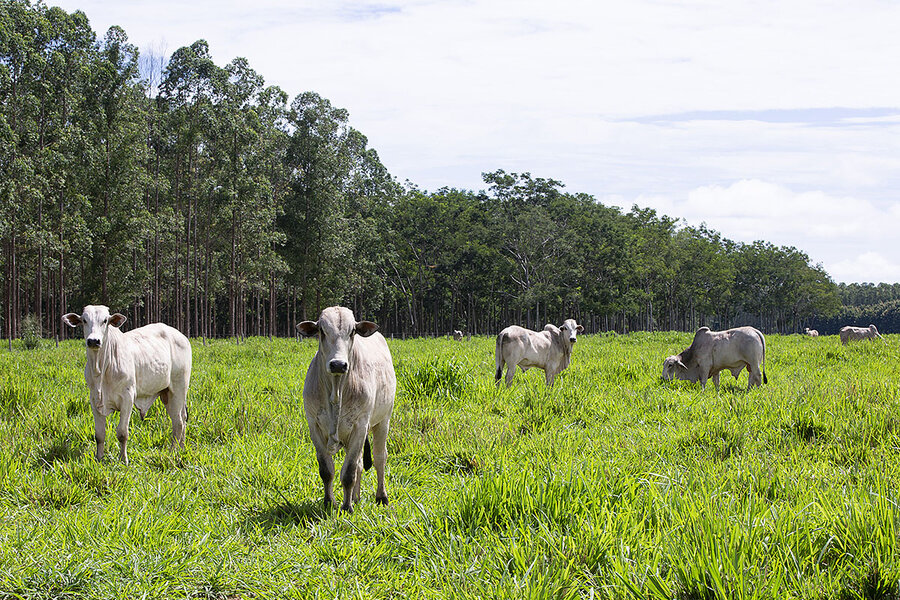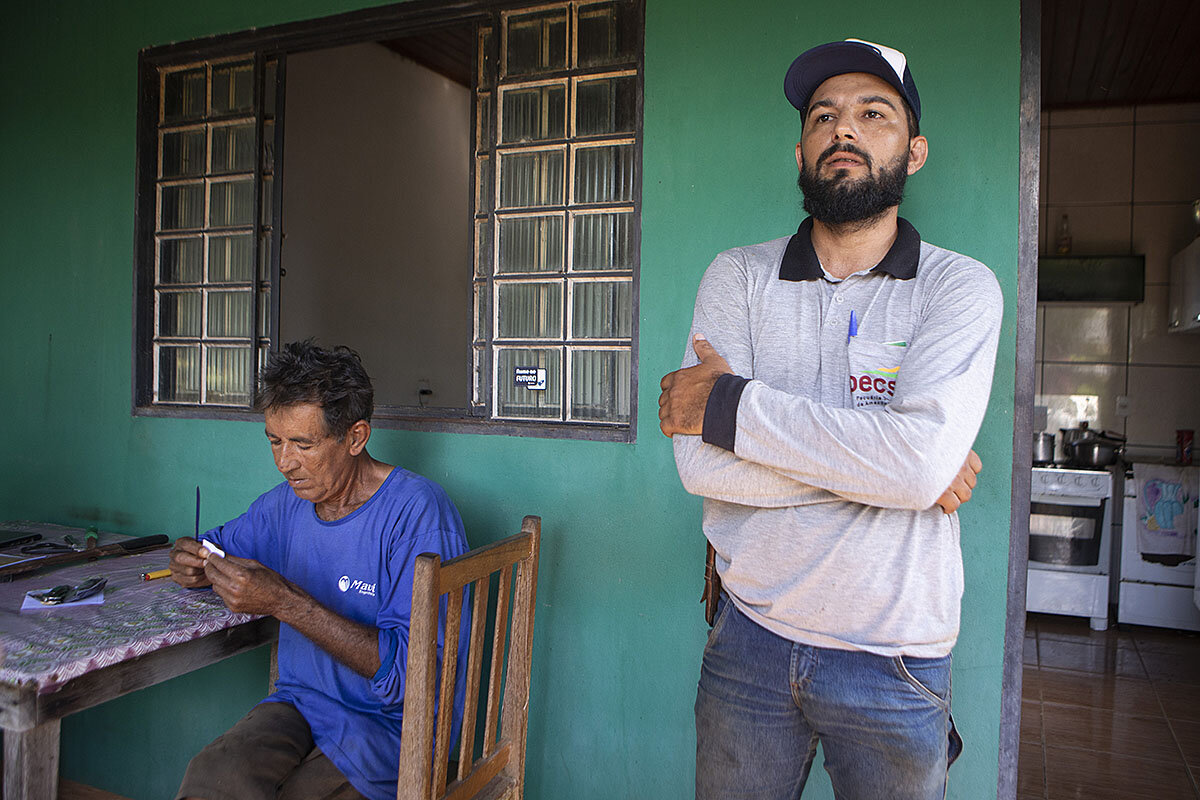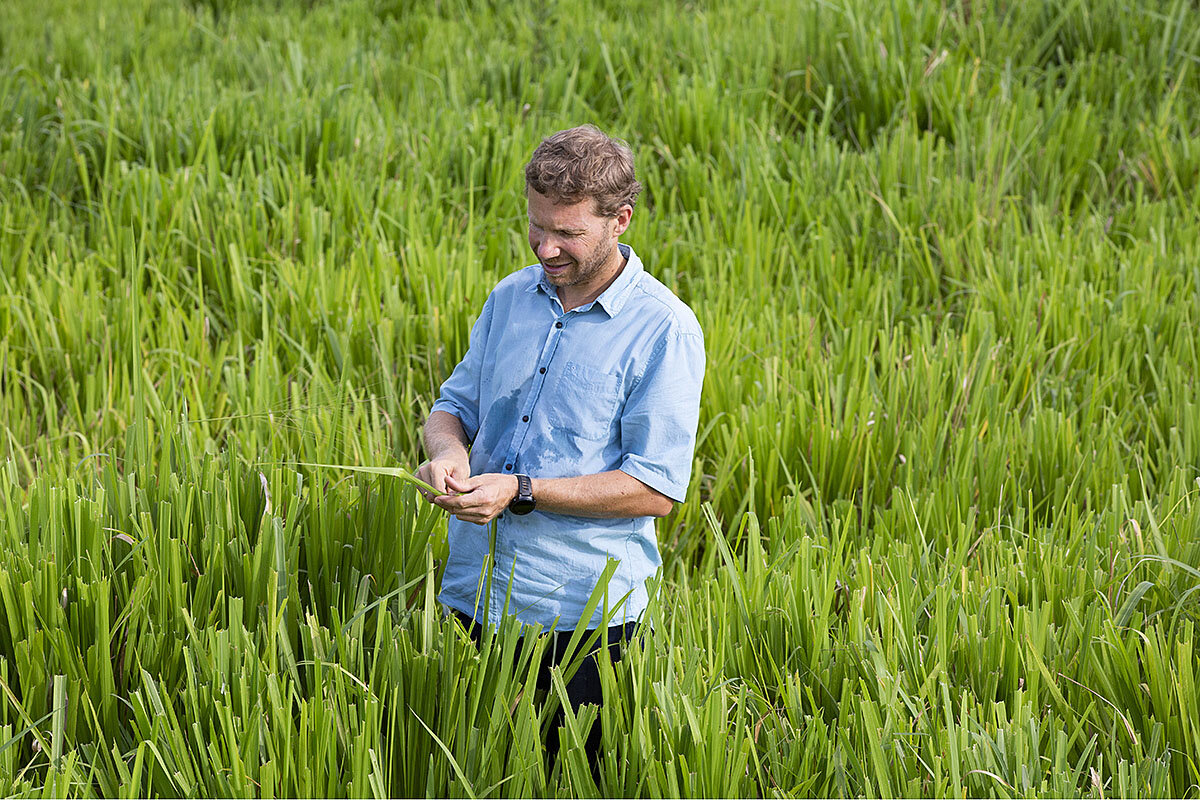Saving the Amazon: How cattle ranchers can halt deforestation
Loading...
| Alta Floresta, Brazil
The white Nelore cattle, their characteristic hunch above their shoulders, graze in the bright green pastures of the Fazenda Mitaju ranch. Around them is the tropical rainforest that survived the clearing of the Amazon that began in the 1970s, when the government lured Brazilians here to settle the vast territory.
Wellison Oliveira Silva supervises this 530-hectare (1,300-acre) ranch. He records the animals’ feed intake daily, rotating them to different parcels of pasture if they are eating too much or too little, and measures the height of the Mombaca grass planted here, which stands anywhere from knee- to waist-high.
His goal: to intensify productivity and get the 2,500 heads to slaughter faster.
Why We Wrote This
Sometimes solutions reside in the problem itself. Responsible for widespread deforestation, cattle ranchers may now hold the key to halting further environmental destruction in Brazil.
To many minds, this would make him one of the most mistrusted figures on the planet. In August, when fires burned in the Amazon, the international community shined a harsh spotlight on Amazonian cattle farmers. And that’s fair. The industry is responsible for up to 80% of the deforestation across the rainforest, according to Yale University’s School of Forestry and Environmental Studies.
But Mr. Silva is not some gnarled farmer intent on fast cash. He’s a 20-something employed by Pecsa (which stands, in Portuguese, for Sustainable Cattle Ranching in the Amazon). A private company spun off from an environmental nongovernmental organization, the group seeks to intensify production on severely degraded pastures and turn them into efficient and sustainable operations. The group believes it’s possible to do so without losing a single hectare more of forest – even as demand for beef from Brazil continues to soar.
Here in the state of Mato Grosso, Brazil’s largest cattle-producing region, ranches that once caused deforestation may now help stop it. “If we don’t start to produce twice, three times, four times and then 10 times more on the already cleared areas, they’re going to clear the Amazon,” says Laurent Micol, a co-founder of Pecsa.
Pecsa joins many efforts – some carrot, some stick, and many controversial – rushing to enforce, incentivize, and generate cleaner sources of beef. In doing so, it hopes to strike a win-win for one of the most maligned sectors in the Amazon.
Battling stigma
Brazil is a leader in forest protection. Its Forest Code requires that up to 80% of a landowner’s property in the Amazon biome be preserved as forest, depending on when it was purchased and how big it is. As environmental pressure has grown over the years, those laws have been more rigorously enforced. The government implemented an environmental registry for each property that maps who owns what and what is produced, and uses satellite imagery to monitor deforestation.
But resources are limited and enforcement sometimes lax. And many worry the Amazon is more vulnerable now that Brazilian President Jair Bolsonaro has taken a pro-development stance in the Amazon that has made him wildly popular.
After dropping dramatically since 2004, deforestation rates have crept up in recent years. Fears came to an international head in the fires last August. Much of the fires were man-made, with land-grabbers, from loggers to cattle ranchers, burning forest to create more pasture.
That’s led to stigma across the entire industry, which comprises more than 200 million heads of cattle.
“The problem is we have a lot of producers of cattle or soybean close to or in the Amazon that are not burning. They are suffering. They are considered the same as deforesters,” says Charton Locks, the chief operating officer of Aliança da Terra, which works to foster sustainable farming in Brazil. “For the international community, it’s all the same. Companies start to avoid buying products from Brazil, which creates a problem for the good producers.”
So Aliança da Terra is trying to differentiate the good farmers. It has built a “Producing Right” platform of 1,500 members, representing more than 5 million hectares of farmland, who adhere to preserving forest, protecting wildlife, and improving social and labor conditions on their ranches.
Rescuing degraded land
On a recent day Willian Campos, a veterinarian by training, visits Fazenda Gamada, a soy and cattle farm an hour from Alta Floresta. He is in charge of ensuring participating farms follow a checklist of over 200 items, a process so rigorous that Mr. Campos says some producers back out once they begin. But those who continue can enter deals with supermarket chains that pay a premium for commodities from green ranches, creating what Mr. Locks calls “a positive ecosystem.”
But not all farms adhere to such high standards voluntarily, and according to many environmentalists, incentives cannot work without stricter enforcement, beyond the current government controls.
In 2009, Greenpeace won a pledge from the largest meatpackers in the Amazon to reject sales from deforested properties. But the results have been limited: Not only does the program not include all meatpackers, monitoring has been limited to direct suppliers, typically the finishing ranch that sells to the meatpacker. That leaves the supply chain exposed.
“I think what’s happened so far is that there are a lot of loopholes, and so people don’t have to take it seriously,” says Lisa Rausch, at the University of Wisconsin-Madison. Using publicly available data, her team and the National Wildlife Federation have developed a traceability tool called Visipec that allows meatpackers to trace indirect suppliers. They are a significant part of the supply chain that could be responsible for about 50% of the deforestation driven by the cattle sector in the Amazon.
Visipec has been available since 2019 and is being offered to the industry for free. But its designers, who say it’s good for business too, say no meatpackers have fully implemented the tool yet.
So-called zero deforestation commodity agreements have been criticized for alienating farmers who are under increasing pressure from the international community. This came to a head in Alta Floresta a decade ago, when the municipality found itself on a government blacklist for deforestation.
That’s how the seeds of Pecsa were planted. Many of those who work at the company today were working at an NGO at the time that helped get farmers off the blacklist.
Alta Floresta is a booming town that sits in the “Arc of Destruction, where today only 45% of the original forest remains. Much of the ranch land is badly degraded, littered with termite mounds that signal nutrient-poor soil below. Many ranches operate at a loss. Pecsa reimagined that land by reforming degraded ranches into sustainable, productive systems that removed incentives to cut deeper into the Amazon.
Pecsa’s model is unlikely. The 65-person team of MBAs, data specialists, zoo technicians, agronomists, and environmentalists take over ranches in multiyear contracts, implementing all of the necessary and costly reforms to transform the property. They invest in new grass to improve the soil, increase the density and productivity, and reforest areas that legally should be conserved. The owners share a percentage of the output.
Transforming cattle ranching
Nothing they have implemented is revolutionary – but their results have been. On a recent afternoon, Mr. Micol, the Pecsa co-founder, drives through muddy roads that cut through a farm they will manage until 2022. When they took over in a pilot project in 2011 and completely in 2016, the grass on this farm, a half-hour west of Alta Floresta, was almost all dead, yellow, and littered with invasive species. The hills around a natural springhole, where the animals would drink, were denuded.
There are now five cattle per hectare, compared to one per hectare when Pecsa took over. Today, the 2,500 cattle drink water and eat feed at a single “leisure center.” When the pasture gets too low, they are rotated to another.
“We consciously decided not to do something too green, not something that was going to be organic, or more ecological,” Mr. Micol says. “It’s just meant to be efficient.”
They have been able to increase productivity, in terms of animal stocking and weight gain, by almost 10 times compared with the region’s average on degraded lands. A study contracted by Imaflora, an NGO, showed that Pecsa-produced meat uses 84% less land and emits 85% fewer greenhouse gases than the baseline. McDonald’s ended its nearly 40-year moratorium on Amazonian beef with a Pecsa contract in 2016.
Pecsa is currently managing 30,000 heads of cattle on 10,000 hectares of ranchland over six properties, with aims to expand to 150,000 heads on 45,000 hectares in three years. “Our purpose is not to run six ranches,” says Mr. Micol, who began his career as a management consultant. “Our purpose is to transform cattle ranching in the Amazon.”
Mr. Silva, the Pecsa supervisor, managed a much larger farm in his previous job. But he joined the staff because he sees it as training for the future. “This is the evolution of the cattle industry in the Amazon,” he says.










